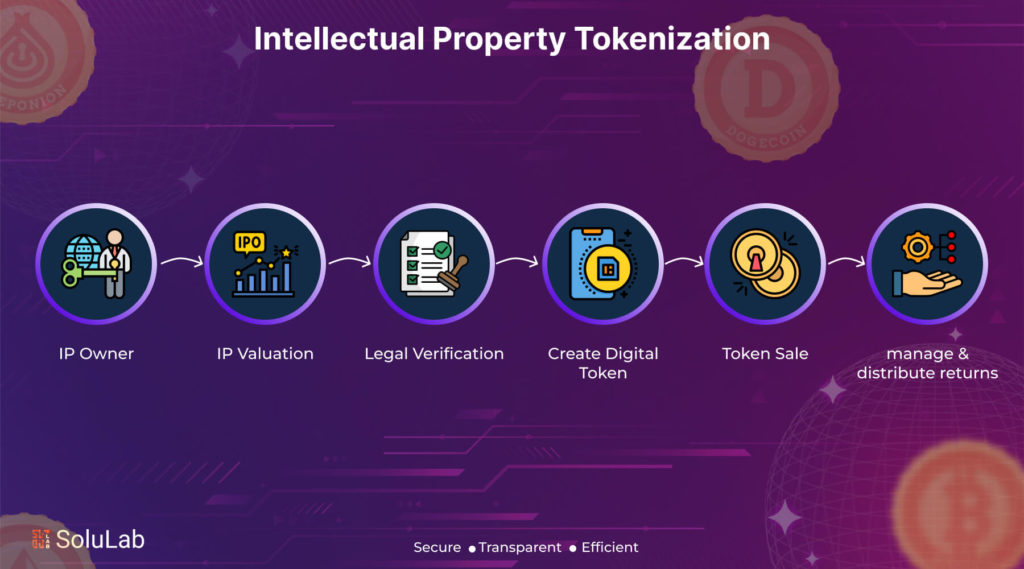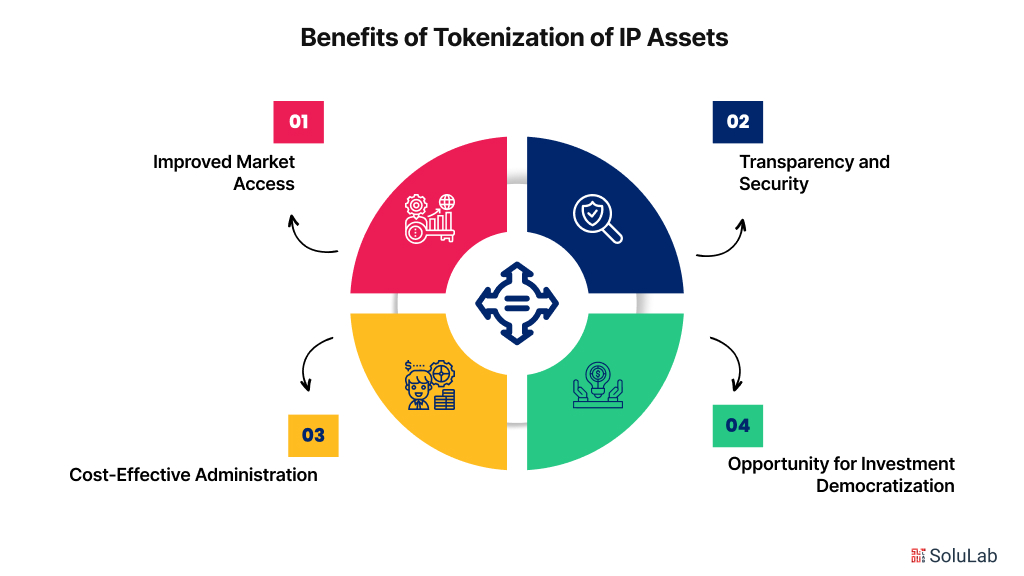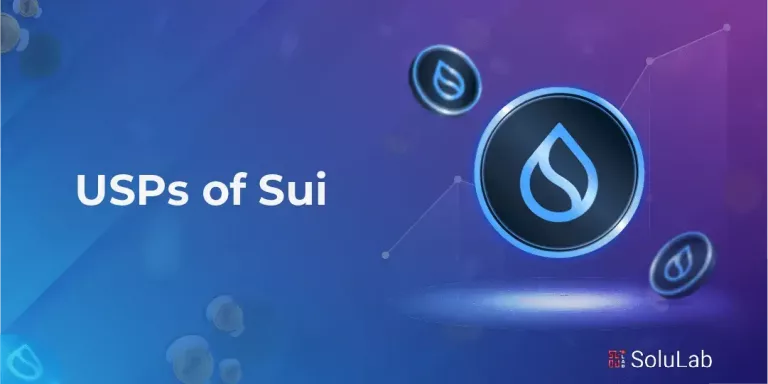
The intellectual property rights management platform is a marketplace solution for IP owners, contributors, and authors. It offers the blockchain’s sole source of truth. The technology allows users to identify ownership charges, create tokens representing intellectual property, register and certify IP, and ease trading with the digital national currency. In a safe and regulated setting, crowdfunding applications enable craters to raise money and investors to invest in the intellectual property of upcoming works.
By 2030, the market for real-world assets, or RWAs may reach $5-16 trillion. In 2024, the rising demand for tokenization caused the value of several asset classes to increase by 400% or more.
They can be exchanged on blockchain-based platforms, and tokenizing IP assets and stablecoins can increase the liquidity of intellectual property assets. Stablecoins and digital tokens make it possible to participate in IP markets globally, lowering entry barriers for investors everywhere.
What is Tokenization?
The process of turning an actual object into a digital representation is known as tokenization. Additionally, tokenization can be used to analyze vast amounts of data efficiently or to protect sensitive data. Small and mid-size businesses are increasingly using tokenization, which aims to reduce the quantity of sensitive data that must be kept on hand, to improve the security of e-commerce and credit card transactions while lowering the expense and difficulty of adhering to legal and industry standards.
Tokenized data is irreversible and unintelligible, in contrast to encrypted data. This distinction is especially crucial since tokens cannot be restored to their original form without the introduction of extra, independently stored data because there is no algorithmic connection between the token’s value and its original number.
What are IP Assets?
Since intellectual property is neither material nor monetary, it is regarded as an intangible asset. The actual forms of tangible goods, like gold, oil, or real estate have objective market value and add value for their owners. Despite not being physical, financial assets like stocks, bonds, and mortgage agreements are seen as tangible since they are represented on paper and serve as claims on tangible company assets.
Intellectual property (IP) assets do not have a physical form or claim to a tangible item. Rather intellectual property is the result of human creativity and is manifested in creativity, designs, symbols, and goods and services, Intellectual property (IP) includes patents, copyrights, trademarks, and trade secrets. The intangible nature of intellectual property makes it challenging to determine its worth. Until recently, the field of IP tokenization has been primarily unexplored. The following are the four categories of intellectual property protection:
- Patents
- Copyrights
- Trademarks
- Trade Secrets
What is Tokenization for IP Assets?
The process of turning intellectual property (IP) assets right into digital tokens and blockchain is known as Tokenizing Intellectual Property. Fractionalizing ownership, improving liquidity, gold tokenization, and enabling more effective IP rights trades are all possible outcomes of this. By integrating this using stablecoins for IP finance, a dependable and steady digital currency is introduced to facilitate IP transactions. As they can be exchanged on blockchain platforms they can increase the liquidity of these IP assets.
How Do Tokenization Of IP Assets Work?
These are the following steps that are commonly used for Intellectual Property Tokenization:
1. Reviewing The Assets
To find out its worth, possible market demand, and viability for asset tokenization, the intellectual property asset whether it be a trademark, a patent, or a copyright undergoes a thorough review.
2. Token Design
The asset is separated into digital tokens based on the evaluation each of which represents a portion or fraction of its intellectual property. Definitions are made for token parameters like ownership rights, supply, and functionality.
3. Development of Smart Contracts
The possession, adaptability, and distribution of tokens are regulated by smart contracts, which are self-executing programs placed on the blockchain for intellectual property. By enforcing the terms and circumstances of intellectual property rights, smart contracts enable automated and transparent transactions.
4. Issuing and Distributing Tokens
The tokens about intellectual property rights are created and given to the appropriate parties. This involves distributing tokens to investors, tokenizing, platforms, the owner of IP, and possible purchasers.
5. Trading and Transfer
By making the tokens tradeable on exchanges and tokenization platforms investors and buyers can buy and sell a portion of IP assets. Transparency, security, and transaction immutability are all guaranteed by the blockchain.
Benefits of Tokenization of IP Assets

Before you tokenize an IP asset, you must look at these advantages of tokenization of intellectual property unfold for you:
-
Improved Market Access
IP asset tokenization into digital currencies that are simple to trade on blockchain-based platforms, and tokenizing intellectual property greatly improves liquidity. Conventional IP asset transactions, which are frequently lengthy and time-consuming, are simplified into quick and effective exchanges. These platforms make it easier for IP assets to be purchased, traded, or licensed.
-
Transparency and Security
Tokenized IP transactions are secure because of blockchain technology. An unchangeable and opaque decentralized ledger records every transaction, offering a strong defense against fraud and unwanted changes, This reduces risks connected with IP assets tokenization by guaranteeing the safe, transparent, and verified ownership and exchange of IP tokens.
-
Cost-Effective Administration
Tokenization streamlines and automates the licensing and royalty procedures, which are typically complicated and time-consuming. The distribution of royalties and execution of license agreements can both be automated with smart contracts. Administrative overheads are significantly decreased when IP management procedures are automated and digitalized through tokenization.
-
Opportunity for Investment Democratization
Tokenized IP on blockchain democratizes investment options by dividing valuable IP assets into lower and more manageable tokens. Before only major firms or rich investors could invest in intellectual property, now a wider spectrum of investors including people and smaller companies, can do so thanks to this fractional ownership model. By reducing the barrier to participation, tokenization makes the IP market more accessible.
What is the Role of Smart Contracts in Tokenized IP?
For many concerns regarding the management and utilization of such valuable assets, there have to be creative solutions in the Tokenized IP rights, which come from smart contracts. Here is a breakdown of their importance:
1. IP Management Automation
Smart contracts dramatically reduce the need for intermediaries through such functions as license agreements and royalties. It accelerates business and ensures that all parties settle the burden accurately and within the due time especially in businesses that have involved royalty payment structures like music and movies.
2. Higher portions in Fractions and Liquidity
Smart contracts make fractional ownership possible as they turn ideas into tokens. This makes it possible for several investors to hold of shares valuable Intellectual Property and enhances the availability of investment. For instance, it will be possible to generate several tokens from one patent; thus, small companies or private investors can participate in the market.
3. Security and Transparency
Smart contracts are based on the blockchain mechanism, due to this, transactions with valuable assets like tokenization of digital assets are safe and transparent. Since no data can be altered on a blockchain, all the transactions are accurately recorded hence less chances of ownership theft and more security to the intellectual property. Combating these issues like IP theft as well as unlawful use, needs this transparency.
4. Community Relations and Management
Also, smart contracts help build decentralized governance models where users and artists would have a say in managing their ideas. This is a community-generated approach that fosters collaboration and innovation, as stakeholders have the means to collectively shape their intangible assets.
Smart contracts are central in the reformation of the policies governing tokenized intellectual property rights through automation, increased open-market trade, security, and globalization. What is more, as this technology is still developing, is it capable of dramatically changing the notion of IP property and its monetization.
Sectors that are Ready for IP Tokenization
IP rights on the blockchain are ideally positioned to make use of IP tokenization across a wide range of sectors which include:
Biotechnology and Medicine
With their potential for large financial gains and creative product offerings, the pharma and biotechnology industries have high-value intellectual property. Toenzied patents can help medical companies fresh sources of funding and make it easier for research groups to share intellectual property. IP-NFTs can also be used to decentralize research, which supports an inclusive, community-driven approach to research while lowering the requirements of patenting or starting a new business.
Entertainment
The idea of digital property rights and commercialization in the creative industry has already changed as a result of artists and content procedures tokenizing their work in response to the explosion of NFT Marketplace Platforms. Entertainment is a related but less-known area that is affected by IP asset tokenization. Tokenizing IP from public domain works and cultural archives can protect and preserve important information while creating new opportunities.
Technology
Similar to biotechnology, other technical domains can greatly profit from the data marketplace and funding opportunities that tokenization makes possible. Software including its source codes and computations can be tokenized by businesses to guarantee that it can be efficiently handled and safeguarded in an online marketplace. Small-scale developers can generate money and compete with larger firms by using tokenizing IP to obtain resources for product design, enhancement, and marketing AI.
Challenges Involved With Tokenizing IP Assets
Here is the breakdown of some of the following possible security risks to owners during IP assets tokenization:
- Risk of cyber security threats because of their nature of being digital as is the case with many other digital currencies, token holders should take appropriate measures not to compromise their accounts. It would be inconvenient to lose your private key and your ownership of an IP token.
- From the regulators’ point of view, merely owning an NFT would most probably be insufficient to gain and prove rightful ownership and ownership rights, especially where one’s private key is lost. Tokenized IP owners and the platforms involved must prepare to alter their standards whenever there is a shift in regulations.
- The first way, or the first category, which can be identified for avoiding compliance with legal and regulatory requirements is getting around legal and regulatory structures.
- Digital tokenization is a need to follow the evolving digital asset legislation and work within a rather convoluted global framework of IP legal instruments.
- Some of the issues that have been triggered by such instances include questions as to whether legalization of represented NFTs, who owns them; and whether minting NFTs by authors infringes on their copyrights.
- Amid tokenization, the legal sphere is again questioning the prospects of IP legislation. In the same way as about other kinds of cryptocurrency assets, On the other hand, updates to the existing ones will continue to appear which will regulate the relationship between innovation and tokenized IP protection reasonably and fairly. However, they will involve factors that may are not clear until things have gone wrong legally.
Can Tokenized IP Make a Liquid Asset?
By providing these assets in smaller, tradeable portions, tokenization enables IP owners to make their assets available to a wider group of investors. Blockchain IP asset management lowers the danger of IP conflicts by ensuring ownership records are transparent, secure, and unchangeable. An IP asset’s value and the quantity of the tokens to be produced must be decided by the asset’s owner before tokenizing the asset. Working with a blockchain development business or a tokenization platform can do this.
The tokens may be offered for sale on a blockchain-based marketplace. The token’s ability to be bought and sold by investors gives the IP liquidity. By generating digital tokens that signify ownership of the IP assets, the tokenization of their assets offers a solution to the liquidity issue. These tokens can be purchased and traded, enabling partial ownership of the assets.
Major Uses Cases of Tokenized IP Assets
| Name | Description |
| CryptoKitties | Cryptokitties was a 2017 Ethereum blockchain-based startup that ked users collect, breed, and exchange unique digital cats in the form of non-fungible tokens (NFTs). By upholding conventional ideas of ownership and the value in the world of digital collectibles, cryptocurrencies showed how tokenization could generate a thriving market. |
| Red Bull Racing | Through their partnership with the blockchain-based platform, Red Bull Racing a well-known Formula 1 racing team gave fans the chance to own digital that depicted memorable moments from fans. Aimed to reward and engage its fan base by tokenization their assets. |
| Eternity | A platform dedicated to bringing digital art on the blockchain and tokenizing it.Seeks to close the gap between conventional art and digital art collections |
How is SoluLab Helpful for the Tokenization of Assets?
By using blockchain technology to convert both physical and intangible resources into digital tokens, SoluLab a Real Estate Tokenization Development Company plays a crucial part in the tokenization of assets. By increasing liquidity, this procedure makes valuable assets like real estate more accessible to a wider range of people by permitting fractional ownership. The security, transparency, and regulatory compliance of these coins are guaranteed by SoluLab’s proficiency in blockchain development.
From ideation to execution, our thorough techniques assist companies in overcoming the challenges of asset tokenization. Borrowland is a decentralized lending network that links lenders and borrowers directly through blockchain technology. A simple interface that streamlines the leading process and smart contracts for automatic loan agreements are two of the platform’s primary features. Borrowland gives consumers more control over how they spend their money. This demonstrates how blockchain technology can completely transform conventional lending procedures by providing a safe and effective substitute. You can view more related case studies and for better information regarding borrowland here.
Additionally, by facilitating smooth ownership transfers and transactions in real estate tokenization as well, SoulLab’s solutions drastically lower the time and expense involved in traditional asset management. They enable industries to adopt the future in finance with the use of effective asset tokenization techniques using developed techniques.
FAQs
1. What is asset tokenization on the blockchain?
Blockchain is being used to tokenize assets which are transforming the existing market dynamics and providing several interrelated advantages. This procedure makes it possible to trade on high-valued assets via digital exchange and increases transparency.
2. Why is tokenization necessary?
Tokenization adds a layer of security by substituting tokens for crucial payment information, decreasing its value to hackers.
3. What are tokenized IP assets used for?
Through tokenization liquid assets can become more fluid making closed investment opportunities more accessible, ownership history can become more transparent, and trading-related administrative costs can be decreased l.
4. What challenges does tokenization pose?
Tokens can be misplaced, stolen, or handled improperly. Inability to work with conventional systems, it can be difficult or impossible to integrate tokenized assets with current legal and financial systems.
5. How is SoluLab using blockchain technology for easing operations?
Blockchain technology is being used by SoluLab to optimize processes in some industries. They improve security and streamline procedures by putting BaaS into practice, which builds stakeholders’ trust.






